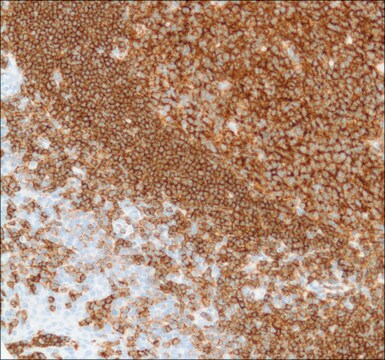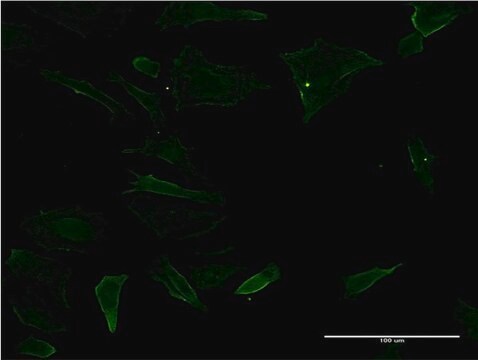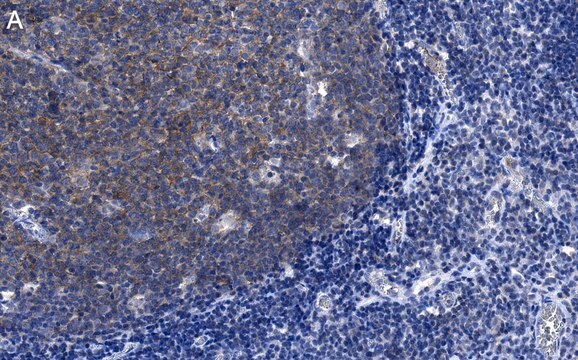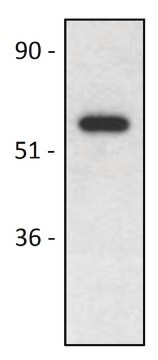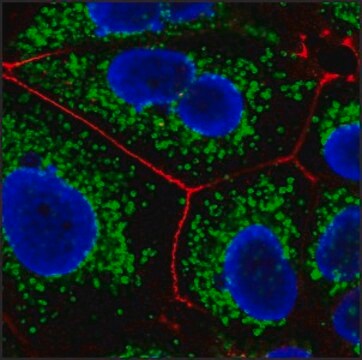SAB4700108
Monoclonal Anti-CD19 antibody produced in mouse
clone 4G7, purified immunoglobulin, buffered aqueous solution
Se connecterpour consulter vos tarifs contractuels et ceux de votre entreprise/organisme
About This Item
Code UNSPSC :
12352203
Nomenclature NACRES :
NA.41
Produits recommandés
Source biologique
mouse
Niveau de qualité
Conjugué
unconjugated
Forme d'anticorps
purified immunoglobulin
Type de produit anticorps
primary antibodies
Clone
4G7, monoclonal
Forme
buffered aqueous solution
Espèces réactives
human
Technique(s)
flow cytometry: suitable
Isotype
IgG1
Numéro d'accès NCBI
Numéro d'accès UniProt
Conditions d'expédition
wet ice
Température de stockage
2-8°C
Modification post-traductionnelle de la cible
unmodified
Informations sur le gène
human ... CD19(930)
Description générale
CD19 (cluster of differentiation 19) is a 95kDa protein localized on the surface of nearly all B lymphocytes and is considered to be the specific surface marker for B cells.This protein belongs to the immunoglobulin (Ig) superfamily with a cytoplasmic region of ∼240 amino acids and is involved in the regulation of B cell function.The protein is encoded by the 7.41kb cd19 gene, mapped on the short arm of human chromosome 16p11.2. There are certain localized regions of strong net negative charges with nine tyrosine residues in the cytoplasmic region of CD19. These regions might regulate the interaction of CD19 with the proto-oncogene Vav, phosphatidylinositol-3 kinase (PI-3 kinase) and the Lyn, Lck and Fyn protein tyrosine kinases.
Immunogène
Human CCL (chronic lymphocytic leukemia) cells
Application
The reagent is designed for Flow Cytometry analysis. Suggested working dilution is 1 μg/mL of sample. Indicated dilution is recommended starting point for use of this product. Working concentrations should be determined by the investigator.
Actions biochimiques/physiologiques
CD19 (cluster of differentiation 19) expression is restricted to normal and malignant B-lineage cells. Therefore, it is considered to be a striking target for immunotherapies aimed at B-cell malignancies. CD19 helps B lymphocytes to initiate primary immune response even at low concentrations of antigen.The encoded protein plays a crucial role in initiating intrinsic B cell signaling thresholds by regulating both B cell receptor (BCR)-dependent and independent signaling. It also functions as a biomarker for B-cell development.
Caractéristiques et avantages
Evaluate our antibodies with complete peace of mind. If the antibody does not perform in your application, we will issue a full credit or replacement antibody. Learn more.
Forme physique
Solution in phosphate buffered saline, pH 7.4, with 15 mM sodium azide.
Clause de non-responsabilité
Unless otherwise stated in our catalog or other company documentation accompanying the product(s), our products are intended for research use only and are not to be used for any other purpose, which includes but is not limited to, unauthorized commercial uses, in vitro diagnostic uses, ex vivo or in vivo therapeutic uses or any type of consumption or application to humans or animals.
Vous ne trouvez pas le bon produit ?
Essayez notre Outil de sélection de produits.
Code de la classe de stockage
10 - Combustible liquids
Point d'éclair (°F)
Not applicable
Point d'éclair (°C)
Not applicable
Faites votre choix parmi les versions les plus récentes :
Déjà en possession de ce produit ?
Retrouvez la documentation relative aux produits que vous avez récemment achetés dans la Bibliothèque de documents.
The CD19/CR2/TAPA-1 complex of B lymphocytes: linking natural to acquired immunity.
Fearon DT and Carter RH.
Annual Review of Immunology, 127-149 (1995)
CD19: a biomarker for B cell development, lymphoma diagnosis and therapy.
Wang K
Experimental Hematology & Oncology, 1 (2012)
The CD19/CD21 signal transducing complex of human B lymphocytes includes the target of antiproliferative antibody-1 and Leu-13 molecules.
Bradbury LE
Journal of Immunology, 149, 2841-2850 (1992)
CD19 monoclonal antibody HD37 inhibits anti-immunoglobulin-induced B cell activation and proliferation.
Pezzutto A
Journal of Immunology, 138, 2793-2799 (1987)
Yan Hu et al.
EMBO reports, 22(7), e52481-e52481 (2021-06-15)
Receptor activator of NF-κB ligand (RANKL) is essential for osteoclast formation and bone remodeling. Nevertheless, the cellular source of RANKL for osteoclastogenesis has not been fully uncovered. Different from peripheral adipose tissue, bone marrow (BM) adipose lineage cells originate from
Notre équipe de scientifiques dispose d'une expérience dans tous les secteurs de la recherche, notamment en sciences de la vie, science des matériaux, synthèse chimique, chromatographie, analyse et dans de nombreux autres domaines..
Contacter notre Service technique